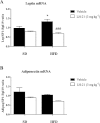Anti-obesity efficacy of LH-21, a cannabinoid CB(1) receptor antagonist with poor brain penetration, in diet-induced obese rats
- PMID: 21951309
- PMCID: PMC3413862
- DOI: 10.1111/j.1476-5381.2011.01698.x
Anti-obesity efficacy of LH-21, a cannabinoid CB(1) receptor antagonist with poor brain penetration, in diet-induced obese rats
Abstract
Background and purpose: Peripheral blockade of cannabinoid CB(1) receptors has been proposed as a safe and effective therapy against obesity, putatively devoid of the adverse psychiatric side effects of centrally acting CB(1) receptor antagonists. In this study we analysed the effects of LH-21, a peripherally acting neutral cannabinoid receptor antagonist with poor brain penetration, in an animal model of diet-induced obesity.
Experimental approach: To induce obesity, male Wistar rats were fed a high-fat diet (HFD; 60 kcal% fat) whereas controls received a standard diet (SD; 10 kcal% fat). Following 10 weeks of feeding, animals received a daily i.p. injection of vehicle or 3 mg·kg(-1) LH-21 for 10 days. Plasma and liver samples were used for biochemical analyses whereas visceral fat-pad samples were analysed for lipid metabolism gene expression using real-time RT-PCR. In addition, the potential of LH-21 to interact with hepatic cytochrome P450 isoforms and cardiac human Ether-à-go-go Related Gene (hERG) channels was evaluated.
Key results: LH-21 reduced feeding and body weight gain in HFD-fed animals compared with the control group fed SD. In adipose tissue, this effect was associated with decreased gene expression of: (i) leptin; (ii) lipogenic enzymes, including SCD-1; (iii) CB(1) receptors; and (iv) both PPARα and PPARγ. Although there were no significant differences in plasma parameters between HFD- and SD-fed rats, LH-21 did not seem to induce hepatic, cardiac or renal toxicity.
Conclusions and implications: These results support the hypothesis that treatment with the peripherally neutral acting CB(1) receptor antagonist, LH-21, may promote weight loss through modulation of visceral adipose tissue.
© 2011 The Authors. British Journal of Pharmacology © 2011 The British Pharmacological Society.
Figures






Similar articles
-
Central versus peripheral antagonism of cannabinoid CB1 receptor in obesity: effects of LH-21, a peripherally acting neutral cannabinoid receptor antagonist, in Zucker rats.J Neuroendocrinol. 2008 May;20 Suppl 1:116-23. doi: 10.1111/j.1365-2826.2008.01693.x. J Neuroendocrinol. 2008. PMID: 18426510 Review.
-
CB1 blockade potentiates down-regulation of lipogenic gene expression in perirenal adipose tissue in high carbohydrate diet-induced obesity.PLoS One. 2014 Feb 25;9(2):e90016. doi: 10.1371/journal.pone.0090016. eCollection 2014. PLoS One. 2014. PMID: 24587189 Free PMC article.
-
Ethanolic extract of seabuckthorn (Hippophae rhamnoides L) prevents high-fat diet-induced obesity in mice through down-regulation of adipogenic and lipogenic gene expression.Nutr Res. 2012 Nov;32(11):856-64. doi: 10.1016/j.nutres.2012.09.015. Nutr Res. 2012. PMID: 23176796
-
A selective cannabinoid-1 receptor antagonist, PF-95453, reduces body weight and body fat to a greater extent than pair-fed controls in obese monkeys.J Pharmacol Exp Ther. 2010 Oct;335(1):103-13. doi: 10.1124/jpet.110.168187. Epub 2010 Jul 6. J Pharmacol Exp Ther. 2010. PMID: 20605903
-
The hepatic cannabinoid 1 receptor as a modulator of hepatic energy state and food intake.Br J Clin Pharmacol. 2014 Jan;77(1):21-30. doi: 10.1111/bcp.12102. Br J Clin Pharmacol. 2014. PMID: 23452341 Free PMC article. Review.
Cited by
-
Low dose naloxone attenuates the pruritic but not anorectic response to rimonabant in male rats.Psychopharmacology (Berl). 2013 Mar;226(2):415-31. doi: 10.1007/s00213-012-2916-5. Epub 2012 Nov 10. Psychopharmacology (Berl). 2013. PMID: 23142959
-
Potential of Cannabinoid Receptor Ligands as Treatment for Substance Use Disorders.CNS Drugs. 2019 Oct;33(10):1001-1030. doi: 10.1007/s40263-019-00664-w. CNS Drugs. 2019. PMID: 31549358 Free PMC article. Review.
-
Benzyl-1,2,4-triazoles as CB 1 Cannabinoid Receptor Ligands: Preparation and In Vitro Pharmacological Evaluation.Int J Med Chem. 2016;2016:1257098. doi: 10.1155/2016/1257098. Epub 2016 Mar 31. Int J Med Chem. 2016. PMID: 27127651 Free PMC article.
-
The Peripheral Cannabinoid Receptor Type 1 (CB1) as a Molecular Target for Modulating Body Weight in Man.Molecules. 2021 Oct 13;26(20):6178. doi: 10.3390/molecules26206178. Molecules. 2021. PMID: 34684760 Free PMC article. Review.
-
Oleoylethanolamide enhances β-adrenergic-mediated thermogenesis and white-to-brown adipocyte phenotype in epididymal white adipose tissue in rat.Dis Model Mech. 2014 Jan;7(1):129-41. doi: 10.1242/dmm.013110. Epub 2013 Oct 23. Dis Model Mech. 2014. PMID: 24159189 Free PMC article.
References
-
- Alvarado M, Goya P, Macias-Gonzalez M, Pavon FJ, Serrano A, Jagerovic N, et al. Antiobesity designed multiple ligands: synthesis of pyrazole fatty acid amides and evaluation as hypophagic agents. Bioorg Med Chem. 2008;16:10098–10105. - PubMed
-
- Arita Y, Kihara S, Ouchi N, Takahashi M, Maeda K, Miyagawa J, et al. Paradoxical decrease of an adipose-specific protein, adiponectin, in obesity. Biochem Biophys Res Commun. 1999;257:79–83. - PubMed
-
- Baker D, Pryce G, Davies WL, Hiley CR. In silico patent searching reveals a new cannabinoid receptor. Trends Pharmacol Sci. 2006;27:1–4. - PubMed
-
- Bellocchio L, Cervino C, Vicennati V, Pasquali R, Pagotto U. Cannabinoid type 1 receptor: another arrow in the adipocytes' bow. J Neuroendocrinol. 2008;20(Suppl. 1):130–138. - PubMed
Publication types
MeSH terms
Substances
LinkOut - more resources
Full Text Sources
Medical

